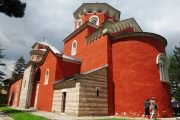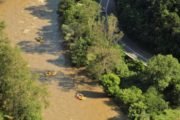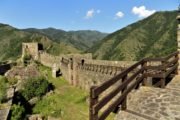Rafting through Valley of Lilacs with exciting rapids from Usce to Maglic fortress. After rafting, it is possible to visit the Maglič Fortress and the Žiča Monastery.
| DEPARTURE LOCATION | Usce (215 km away from Belgrade and 50 m south from Kraljevo) |
| DEPARTURE TIME | flexible, the latest by 1 PM |
| INCLUDED IN THE PRICE | Rafting on Ibar River with duration 3h
Necessary equipment for rafting (rubber boat, safety vests, helmets, neoprene suits, and boots), instructors and skippers A tour organization |
| NOT INCLUDED | Transportation to the starting location
Lunch Other individual costs |
Additional notes:
- We recommend clothes that dries up quickly and does not soak too much water. You can wear it under a neoprene suit. Ibar rafting does not require previous rowing experience. You can find some more answers in the section Frequently asked questions (FAQ)..
- For the realization of the tour, it is necessary to have a minimum of 5 entries
- Payment: 50 % at registration, the rest at least 5 days before the tour.
- After rafting we can organize lunch and a sightseeing tour of the surroundings.
- Transport: own or we can arrange it for a minimum of 7 people.
Nearby attractions
Maglič fortress
It is not known when Maglich was erected, but it is believed that he was probably raised by Uros I after the Mongol invasions, to prevent the penetration of new invasions through the Ibar Gorge, that is, to protect the access to his endowment from the Sopocani and Nemanja Studenica from that side.
Another assumption is that in the early 13th century, he was raised by Uros's father Stefan the First-Crowned to protect his endowments Zica and Studenica.
The development of the Serbian medieval state and its shift to the south contributed to the loss of importance to Maglic, as a fort in the heart of the country far from borders and potential conquerors. So it's no wonder that it was the seat of Serbian Archbishop Danilo II. He was in charge of both church and state affairs from Maglic. He also organized writing church books within the city.
The organizer of the tour is the travel agency Explore Balkans doo. With this program is valid Rulebook on conducting tours by Explore Balkans doo. According to Article 79 of the Law on Tourism, protection is not provided for one-day tours in terms of travel guarantees.
Belgrade – Usce
- Departure from your destination in the morning
- Travel to Usce, which is located south of Kraljevo, about 50 km
Rafting Ibar
- Preparation for the rafting tour
- Rafting on Ibar River, 3h with breaks for swimming
- Lunch
- Optional sightseeing tour of the Maglič Fortress and the Žiča Monastery
- Return home/accommodation, where you arrive in the evening.
Maglič fortress
It is not known when Maglich was erected, but it is believed that he was probably raised by Uros I after the Mongol invasions, to prevent the penetration of new invasions through the Ibar Gorge, that is, to protect the access to his endowment from the Sopocani and Nemanja Studenica from that side.
Another assumption is that in the early 13th century, he was raised by Uros's father Stefan the First-Crowned to protect his endowments Zica and Studenica.
The development of the Serbian medieval state and its shift to the south contributed to the loss of importance to Maglic, as a fort in the heart of the country far from borders and potential conquerors. So it's no wonder that it was the seat of Serbian Archbishop Danilo II. He was in charge of both church and state affairs from Maglic. He also organized writing church books within the city.
Zica monastery
Žiča is a Serbian medieval monastery dating from the first half of the XIII century, located near Kraljevo.
The monastery, together with the Church of the Holy Dormition, was built by the first King of Serbia, Stefan the First-Crowned and the first Head of the Serbian Church, Saint Sava. Žiča was the seat of the Archbishop (1219–1253), and by tradition the coronational church of the Serbian kings, although a king could be crowned in any Serbian church, he was never considered a true king until he was anointed in Žiča. Žiča was declared a Cultural Monument of Exceptional Importance in 1979, and it is protected by Serbia. In 2008, Žiča celebrated 800 years of existence.
In 1219, Žiča became the first seat of the Serbian Archbishopic. The church, dedicated to the Ascension of Our Lord, displays the features of the Raska school. The ground plan is shaped as a spacious nave with a large apse at its eastern end. The central space is domed. The church was built of stone and brick. Architecturally, the Byzantine spirit prevails.
There are two layers of painting, each being a separate entity.
- older - originated around 1220 and belongs to the Golden Age of Serbian Painting
- younger - formed at the beginning of the 14th century and belongs to the painting from the age of King Milutin, created under the influence of the Renaissance Paleologist, which can be said to be representative examples of the painting.
During the Ottoman rule, the monastery was abandoned on several occasions, after which it was restored.
Žiča was declared a Cultural Monument of Exceptional Importance in 1979, and it is protected by Serbia. In 2008, Žiča celebrated 800 years of existence.




























